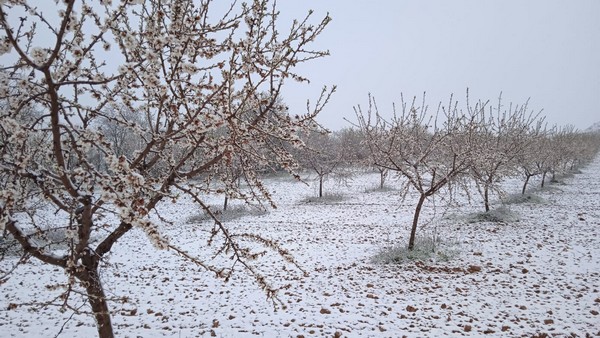Given the weather vagaries which have affected crop production in recent years, it's not surprising that the related conditions are closely intertwined with crop insurance rules, claims, and payments. Area farmers were reminded of that impact during annual updates sponsored by Premier Insurance Solutions LLC.
“Logic does not always apply” in how the rules, policies, and timetables were interpreted and decided in 2019 to address the frequency of prevented plantings and delayed harvesting, Premier co-owner Craig Ladwig told attendees at the meeting held in Sheboygan County.
Founded in 2003, Premier Insurance has 15 agents who serve clients in Wisconsin, Illinois, Indiana, Iowa, Michigan, and Minnesota. It writes policies with six national insurance companies – all of which offer several add-on products to augment the subsidized basic federal crop insurance.
Review of Recent Changes
In wake of what has happened recently and for what's on the horizon for 2020, Ladwig pointed out that the 2018 federal Farm Bill will be in effect through 2023. For 2020 in particular, the federal subsidies will be the same as in 2019 with the possibility that some of the farmer premiums will be a bit lower, he noted. The only significant change is that per crop/per county fee for catastrophic coverage, which very few farmers select, is being raised from $300 to $655.
Two timetable changes made for 2019 only were January 31, 2020 payment deadline (without interest) on premiums for spring crop insurance (corn and soybeans) compared to the previous deadline of September 30, 2019, Ladwig said. In addition, the deadline for reporting crop acreages to the federal Farm Service Agency (FSA) for 2019 was moved to July 22 from July 15.
In other FSA updates, Ladwig explained that the agency will stop mailing newsletters and will require farmers to sign up for e-mail or text messages instead, recommended that growers update their yields from 2013-2017 for the Price Loss Coverage payment program, and pointed out that farmers in 24 Wisconsin counties are eligible for losses due to flooding in either 2018 or 2019 or both.
Hemp Crop Coverage
Multi-peril crop insurance for hemp will not be available separately in 2020 but coverage for hemp will be available in whole-farm policy, Ladwig said. Another option for hemp is to obtain hail insurance coverage for a premium of $1.75 per $100 of crop value. He noted that the hemp grower must have a contract with a buyer and that the maximum coverage (up to about $1,500 per acre) varies among the insurance companies.
Although its popularity has been slipping, Ladwig touted the value of hail insurance, which is offered only by private insurance companies. The low cost (about 40 cents per $100 of coverage), acre by acre coverage, the zero deductible, the multiple types of losses it can cover, and the one-hour window for sign-up in the case of an impending hailstorm make it worth considering, he said.
In addition to fodder loss, green snap, wind damage, and extra harvest expense in the field, hail insurance also offers extras for losses by fire (standing crop or storage units), vandalism (driving technique expeditions in fields), and spillage from a wagon or grain cart. He noted that a general farm liability policy can also cover such losses but emphasized the insurance agent must be informed about all of the land parcels for which coverage is intended.
Forage Coverage
What Ladwig considers as “probably the best coverage of all” are the policies for both the spring and fall seeding of forages. He notes that there is no deductible for either planting period and that there are three acceptable final planting date zones within Wisconsin for both May and August.
For the spring seeded forage (primarily alfalfa), the insurance provides a per acre dollar amount of coverage. Payments are based on plant count stands per square foot. One restriction on the spring seeding is an August 15 final date for harvesting the crop.
In the past, a written agreement was required to obtain coverage for the fall (August) seeding of forage, Ladwig noted. He reported that the Risk Management Agency (the overseer of federal crop insurance) will be determining if regular coverage would be available by the fall of 2020 for the 2021 crop year.
Prevented Planting Woes
Prevented planting of spring crops rose to the forefront again as a claim in 2019. Among Premier's clients, 95 percent of those in east-central Wisconsin, 74 percent in the southeast, and 40 percent each in the southwest and north-central regions filed a prevented planting claim in 2019, he said.
Among the cautions for prevented planting claims is the need to contact the agent within 72 hours of the decision to not plant, the requirement for a minimum of 20 acres or 20 percent of the crop's acres in the insured unit, the limit on the number of acres (highest number insured for the crop within the previous four years), and the limit of one claim on the acreage for the year – no claim for both failed winter wheat and a spring-planted crop in the same year, Ladwig explained.
For 2020, land which was planted and harvested within at least one of the past three years may be eligible for a prevented planting claim. Ladwig urges checking with one's insurance agent for the options and rules regarding prevented planting and advises growers who received payments in 2019, especially those who would ordinarily not have sold the harvested crop in 2019, to talk with their accountant/tax preparer about reporting at least a portion of the payment in 2020 instead.
Observing the Rules
Another concern is to be accurate and honest about acres and dates regarding prevented planting and the location-based final planting dates for certain crops, Ladwig stressed. He noted that the FSA is able to obtain aerial photos of one's land as often as every seven days.
Among the exceptions for 2019 due to prevented planting (made in a late June announcement) were allowing the growing of soybeans as an eligible cover crop along with also considering corn as a cover crop provided that either the per acre population was more than 35,000 plants, rows were narrower than 30 inches, or nitrogen applications were limited. In addition, extra payments were authorized for both the popular revenue and yield policies for corn and soybeans, he said.
In case of replanting, the 20/20 rule also applies, and in one of the less than logical rule applications, the initial planting date is still used provided that the replanting was done within 10 days of the designated latest planting date for the location, Ladwig said. He also reminded growers that many seed companies offer discounted or even free seed for replanting.
For “silage-specific corn,” the crop can only be insured as silage, meaning that the coverage is for tonnage, not revenue, Ladwig explained. He noted that the silage price is set annually by the RMA and warned that the agency “is cracking down” on having growers declare that the corn is silage-specific.
Follow Through on Policies
On related points, appraisals are always a good practice even when no loss claim is anticipated – if only to document yields. He noted that appraisals are required for harvesting silage and high-moisture grain corn and for any insured crop that is destroyed.
Corn quality factors such as high moisture and low test weights “were huge” with the 2019 crop. For crop insurance purposes, corn is dried to 15 percent moisture and soybeans to 13 percent with the use of a 1.2 factor although buyers often use a different ratio, he said.
Additional discounts apply if the test weights are below 49 pounds per physical bushel and yields for that corn will also be discounted. With the 2019 crop, it was not unusual to harvest grain corn with up to 40 percent moisture and test weights in the 40s, he added.
Testing Requirements
With the costs being borne by the insured grower, tests are required to obtain deductions for aflatoxins and vomitoxins, Ladwig pointed out. For aflatoxins, the insurance adjuster must take a sample in the field. For vomitoxins, a third party takes a sample to be tested in a federally certified lab for awarding a discount if the concentration is over 5 parts per million.
When a buyer rejects a load, the insurance agent must be contacted to start an insurance claim. Ladwig noted that an elevator's rejection letter must be specific to the situation and that the insurance company has the right to look for a buyer of what was rejected.
Ladwig reminds all insured growers that March 15 is the deadline for informing one's agent about any changes in the farming operation for 2020. This includes changes in ownership or marital status, in signing authority, in the acres that are being insured or how they are being structured, and the levels of coverage.
Source - https://www.wisfarmer.com












